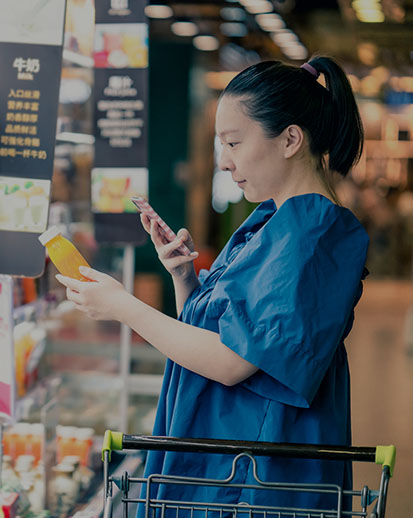Our approach to the Sustainable Development Goals
The UN Global Goals for Sustainable Development (SDGs)
In 2016, the United Nations launched the SDGs, a roadmap to a more environmentally and socially conscious and responsible world by 2030. Companies have a key role to play in achieving the SDGs and we believe that our combination of Health, Nutrition & Bioscience contributes toward achieving the SDGs.
Working on the SDGs
With our strong combination of scientific competences and our portfolio of health and nutrition solutions, we are ideally positioned to contribute to, and capture the growth opportunities offered by, the urgent societal and environmental consequences associated with how the world currently produces and consumes food. Our long-term strategy is based on challenges in our food systems and the SDGs. In 2021, we announced our new Food System Commitments for 2030 that demonstrate how we contribute to a positive impact on Health for People, Health for the Planet, and Healthy Livelihoods. For more information on how we contribute to food systems transformation, please see Food System Commitments.
Our initiatives and actionable framework comprise three pillars:
- Improve: We improve our own operations to do no harm to people and planet. We optimize our own operational impact by continually raising safety standards, promoting health and well-being in our own workforce, reducing our emissions and our impact on nature/biodiversity and improving our resilience, increasing our use of renewable energy, reducing our water consumption, and unlocking more value from limited resources
- Enable: We enable our customers and partners to have a positive impact by delivering products and solutions that enable them to deliver sustainable and healthy solutions for the planet and society
- Advocate: We advocate in our business ecosystem for systemic change – we advocate for the future we believe in and we fully accept our responsibilities as a corporate member of society
Our purpose and strategy align most closely with five of the SDGs, and we show here how we approach these core SDGs. Information about our engagements can be found in the Sustainability statements and throughout this Report.
SDG 2 and SDG 3
Through our commitments, initiatives, and approach, we align most closely with the following SDG targets: 2.1, 2.2, 2.3, 3.2, 3.4 and 3.9.
The link between adequate nutrition and health has never been clearer. Diet-related non-communicable diseases (including type 2 diabetes, heart disease, stroke, and some cancers) have overtaken communicable diseases as the primary cause of deaths worldwide. At the same time, malnutrition in its various forms affects a significant portion of the world’s population: around 40% of adults and 20% of children are overweight or obese, 3.1 billion people are unable to afford a healthy diet, and approximately 2.3 billion were moderately or severely food insecure (Global Nutrition report 2022). Recent research (Lancet, 2022) shows that at least 3 billion people suffer from one or more vitamin or mineral deficiency. Furthermore, the research found that half of all preschool-aged children and more than two-thirds of women of reproductive age fail to consume the most crucial nutrients needed for growth and development.
Our commitments
- We will help fill the micronutrient gap experienced by 800 million people by 2030 by the provision of fortified staple foods and health supplements that offer a proven and cost-effective method of combating malnutrition, as well as by empowering consumers to achieve healthier diets
- We will support the immunity of 500 million people by 2030 by delivering essential vitamins, minerals and other ingredients to consumers worldwide through high-performance dietary supplements
- Together with our partners, we will support the livelihoods of 500,000 smallholder farmers across value chains by 2030; we will achieve this by scaling up our innovative social enterprise model, Africa Improved Foods
Our initiatives
- We create awareness about the benefits of healthy diets and improved nutrition while continuing to develop new food solutions together with our partners of the World Business Council for Sustainable Development, the World Food Programme, World Vision, UNICEF, GAIN and the Sun Business Network
- It is our responsibility to obtain comprehensive information on the safe use of our products, and to make conscious choices concerning the substances we use and produce, taking into account the whole product life cycle
Our approach
Improve
By reducing occupational safety incidents and promoting health & well-being in our own workforce, including good workforce nutrition, whereby we inform our employees about what constitutes a healthy diet, how consumers can make healthy choices and about the role of healthy nutrition throughout life stages.
Enable
By supporting customers to enable the production of healthy and affordable food and nutrition through solutions such as the sustainable production of animal protein foods (such as dairy, eggs, meat, poultry and fish), plant-based protein foods, fortified staples and public health supplements, immunity-supporting solutions, and food & beverage solutions.
Our biomedical solutions improve quality of life for surgical patients. and improve people’s health status.
Advocate
We advocate a food system transformation that provides nutritious food that is sustainably produced, in partnerships to address sustainable and healthy nutrition through partners such as the World Business Council for Sustainable Development’s (WBCSD) and the World Economic Forum (WEF), and in partnerships to fight malnutrition, such as the UN World Food Programme (WFP), UNICEF, World Vision International and Scaling Up Nutrition (SUN).
SDG 7 and SDG 13
Through our commitments, initiatives, and approach, we align most closely with the following SDG targets: 7.2, 7.3, 13.2 and 13.3.
The stability of the world’s climate is under threat. We believe there is an urgent need to take action to curb climate change and its irreversibly damaging effects by dramatically limiting greenhouse gas emissions, transitioning to renewable energy, and adopting low-carbon emission solutions and processes. At the same time, it is also crucial to strengthen the resilience and adaptive capacity of societies against intensifying climate hazards and their impact on people and the environment.
The food, agriculture and forestry sectors are responsible for at least one quarter of anthropomorphic greenhouse gas emissions (IPCC, 2021). Agri-food also signficantly impacts biodiversity loss on land and in the oceans. Transforming food systems from farm to fork will therefore be key to reduce environmental impacts and mitigate climate change while ensuring food stays affordable and farmers are provided a healthy livelihood.
The transition to a low-carbon economy will also create business opportunities and drive growth for our innovative and sustainable solutions. We contribute to the development of a low-carbon economy not just by reducing our own emissions but also by developing solutions to help customers and consumers to cut theirs.
Our commitments
- We commit to reaching net-zero emissions across our value chains by 2050, aligning our actions with a 1.5°C ambition, and to set us on this path, we work with our Science Based Targets (SBT), comprising a scope 1 + 2 absolute reduction of 59% and a scope 3 intensity reduction of 28% by 2030 versus baseline 2016
- We will enable double-digit reductions in emissions from on-farm livestock by 2030
- We will reach 150 million people with nutritious, delicious, sustainable plant-based protein foods by 2030
- Our SBTs are supported by targets of an average annual energy efficiency improvement of >1% and 100% purchased electricity from renewable sources by 2030
Our initiatives
- We apply an internal carbon price of €100/t CO2eq to our key investments and acquisitions
Our approach
Improve
Our long-term goal is net-zero emissions by 2050 at the latest. To put us on track to achieve this, by 2030 we will reduce our own carbon footprint and improve the resilience of our assets and supply chains. Our approach to resilience and adaptation, including physical and transition risk assessments, is summarized in Taskforce on Climate-related Financial Disclosures (TCFD).
Enable
By enabling the low-carbon economy through solutions that help customers cut emissions and improve society’s ability to adapt to climate change. These include products with significantly lower carbon footprints (such as Quali-C®), improving the sustainability of animal farming (such as Bovaer®, which reduces methane emissions from cows by 30% or more) and advancing plant-based protein options (such as CanolaPRO®).
Advocate
We advocate accelerated climate action and building the movement for a low-carbon, resilient economy by showcasing solutions and best practices in key climate platforms such as COP26 and through collaboration with cross-domain initiatives such as the World Economic Forum (WEF) and We Mean Business, and leading thematic climate platforms such as the Carbon Pricing Leadership Coalition (CPLC) and RE100.
SDG 12
Through our commitments, initiatives, and approach, we align most closely with the following SDG targets: 12.2, 12.3, 12.4 and 12.5.
As the world’s population grows, demand for the Earth’s resources will only continue to rise, and with a population projected to grow to 9.7 billion people by 2050, some estimates suggest we will need the equivalent of three Planet Earths by then to sustain our current lifestyles. In addition, over 30% of all food produced is either lost or wasted, representing a huge drain on natural resources. Considering our global economy is only 8.6% circular and that planetary boundaries are already crossed, society as a whole must move away from linear production and consumption systems and work together to build sustainable food and production systems. We are making important contributions to the development of a circular, bio-based economy founded on closed-loop solutions.
Our commitments
- We will improve water withdrawal efficiency in water-stressed areas by 10% by 2030 versus 2020
- We will maintain improvements in our total process-related waste efficiency and work towards a new target of 50% absolute landfill reduction by 2030 vs. 2020
Our initiatives
- ‘Safe and sustainable by design’ is the leading principle in the development of new and better products and processes
- We act as advocates for SDG 12.3 ‘Halving food loss and waste’ and we actively support our customers with reducing food loss and waste reduction from farm to fork, for instance in the dairy, juice, meat and eggs value chains
Our approach
Improve
By unlocking more value from the limited available resources. Water security, waste management and our impact on nature and biodiversity are important aspects of our continuous improvement mindset. We minimize the use of substances of concern wherever possible.
Enable
By enabling our customers to design safer and more circular end-products, and to minimize the use of finite resources by using renewable raw materials and valorizing by-products. These include our solutions Veramaris®1 and CanolaPRO®.
Advocate
We advocate the transition from a linear to a circular and bio-based economy through global platforms such as the World Business Council for Sustainable Development (WCBSD), and the reduction of food loss and waste through Champions 12.3.
1 Veramaris® is a trademark owned by Veramaris V.O.F, a joint venture between DSM and Evonik
Our contribution across the SDGs
Our purpose-led, performance-driven strategy is based on global megatrends and the SDGs. We align our approach with five ‘core’ SDGs: SDG 2 and SDG 3, SDG 7 and SDG 13 and SDG 12. In addition to these ‘core’ SDGs, we believe that we can also apply our Improve, Enable and Advocate approach to a varying extent across all the SDGs. Below we indicate our estimated contribution in respect of all the SDGs.




